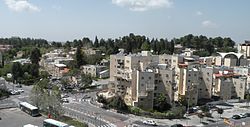Kfar Shaul Mental Health Center: Difference between revisions
add link |
add holocaust survivors & ref |
||
| Line 28: | Line 28: | ||
*Kananah, Sharif and Zaytuni, Nihad. ''Deir Yassin''. Birzeit University Press, 1988, pp. 5, 57.</ref> The hospital opened in 1951, utilizing the abandoned homes and school. The new hospital at first housed a [[therapeutic community]] of around 300 patients who spent almost all their time outdoors, and was called the Kfar Shaul Government Work Village for Mental Patients.<ref>''Progress in Psychotherapy'', American Psychiatric Association, Grune & Stratton, 1949. |
*Kananah, Sharif and Zaytuni, Nihad. ''Deir Yassin''. Birzeit University Press, 1988, pp. 5, 57.</ref> The hospital opened in 1951, utilizing the abandoned homes and school. The new hospital at first housed a [[therapeutic community]] of around 300 patients who spent almost all their time outdoors, and was called the Kfar Shaul Government Work Village for Mental Patients.<ref>''Progress in Psychotherapy'', American Psychiatric Association, Grune & Stratton, 1949. |
||
*Khalidi, Walid. ''All That Remains: The Palestinian Villages Occupied and Depopulated by Israel in 1948'', Institute for Palestine Studies, 1992, p. 292. |
*Khalidi, Walid. ''All That Remains: The Palestinian Villages Occupied and Depopulated by Israel in 1948'', Institute for Palestine Studies, 1992, p. 292. |
||
*Hodgkins, Allison B. ''Israeli settlement policy in Jerusalem''. Palestinian Academic Society for the Study of International Affairs, 1998, p. 109.</ref>Along with other psychiatric facilities in Israel, Kfar Shaul suffers from severe overcrowding and an average occupancy rate of 110 percent.<ref>[http://www.haaretz.com/print-edition/news/patients-sleeping-in-dining-rooms-of-overcrowded-j-lem-facilities-1.2059 Patients sleeping in dining rooms of overcrowded J'lem facilities ]</ref> |
*Hodgkins, Allison B. ''Israeli settlement policy in Jerusalem''. Palestinian Academic Society for the Study of International Affairs, 1998, p. 109.</ref> |
||
Along with other psychiatric facilities in Israel, Kfar Shaul suffers from severe overcrowding and an average occupancy rate of 110 percent.<ref>[http://www.haaretz.com/print-edition/news/patients-sleeping-in-dining-rooms-of-overcrowded-j-lem-facilities-1.2059 Patients sleeping in dining rooms of overcrowded J'lem facilities ]</ref> |
|||
==Jerusalem Syndrome== |
==Jerusalem Syndrome== |
||
Revision as of 15:19, 11 November 2010
| Kfar Shaul Mental Health Center | |
|---|---|
 | |
 | |
| Geography | |
| Location | Kfar Shaul, located between Givat Shaul and Har Nof, Jerusalem, Israel |
| Coordinates | 31.787329, 35.1774 |
| Organisation | |
| Funding | Public hospital |
| Services | |
| History | |
| Opened | 1951 |
Kfar Shaul Mental Health Center, established in 1951, is an Israeli public psychiatric hospital in Givat Shaul, Jerusalem. It is affiliated with the Hadassah Medical Center and the Hebrew University of Jerusalem. [1] The hospital is Jerusalem's designated psychiatric hospital for tourists who display mental health disturbances, and is widely known for its research on Jerusalem Syndrome.[2]
Etymology
Kfar Shaul (lit. Saul's village) is named for King Saul. Udi Aloni, punning on the name, writes that "Kfar Shaul" could also mean "borrowed village."[3]
History
The hospital was established on the intact Palestinian village of Deir Yassin, which was captured in April 1948, a month before the declaration of Israeli independence. [4] The hospital opened in 1951, utilizing the abandoned homes and school. The new hospital at first housed a therapeutic community of around 300 patients who spent almost all their time outdoors, and was called the Kfar Shaul Government Work Village for Mental Patients.[5]In the early years, the majority of patients were Holocaust survivors. [6]
Along with other psychiatric facilities in Israel, Kfar Shaul suffers from severe overcrowding and an average occupancy rate of 110 percent.[7]
Jerusalem Syndrome
The hospital is also known for its association with Jerusalem Syndrome, a condition in which the sufferer is gripped by religious delusions. The hospital sees some 50 patients a year who are diagnosed with the condition.[8] Israel psychologist Gregory Katz has said many of the patients are Pentecostals from rural parts of the United States and Scandinavia.[9] The syndrome was first diagnosed in 1993 by Yair Bar-El, a former director of the hospital.[10]
See also
References
- ^ G. Katz 2002.
- ^ "The Jerusalem Syndrome", Jewish Virtual Library, accessed August 19, 2010.
- ^ Aloni, Udi. "The specters of Kfar Shaul", Haaretz, January 2, 2010.
- ^ Ettinger, Yair. "Deir Yassin massacre, 55 years on", Haaretz, April 10, 2003.
- Gelber, Yoav. "Propaganda as History: What Happened at Deir Yassin?", Sussex Academic Press, 2006.
- Kananah, Sharif and Zaytuni, Nihad. Deir Yassin. Birzeit University Press, 1988, pp. 5, 57.
- ^ Progress in Psychotherapy, American Psychiatric Association, Grune & Stratton, 1949.
- Khalidi, Walid. All That Remains: The Palestinian Villages Occupied and Depopulated by Israel in 1948, Institute for Palestine Studies, 1992, p. 292.
- Hodgkins, Allison B. Israeli settlement policy in Jerusalem. Palestinian Academic Society for the Study of International Affairs, 1998, p. 109.
- ^ Challenged children get a bird's-eye view of Masada
- ^ Patients sleeping in dining rooms of overcrowded J'lem facilities
- ^ Crazy? Hey, you never know, Time magazine
- ^ Mandelbaum, Judy. "The 'Jerusalem Syndrome': An Endangered Species?", Emunah, August 17, 2010.
- ^ Crazy? Hey, you never know, Time magazine
